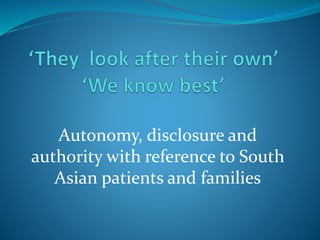
Autonomy, disclosure and authority with reference to South Asian patients and families
- 1. Autonomy, disclosure and authority with reference to South Asian patients and families
- 2. The Dilemmas A conflict of interest between the needs of the dying person to prepare for death, and relatives who fear that such knowledge may cause them to give up hope and die too soon. For professionals in the UK, the conflict between the desire to respect patient autonomy, and to discuss the prognosis and treatment directly with the patient, whereas relatives wish to protect them from knowledge which might prove harmful and cause them to die prematurely. The ‘they care for their own’ syndrome – an assumption by the professionals that the patient is part of an extended or joint family who can take responsibility. This affects referrals. However, there may not be an extended or joint family, lack of knowledge about services or local support.
- 3. Good Deaths A conscious, prepared death, detached and with the mind on God Rites of purification, penance. May fast Unfinished business dealt with Family around to say goodbye, help the person move to next life with prayers etc. Death in sacred space of home, with Ganges water or Amrit (for Sikhs) in the mouth
- 4. Familial Cultures In Asian relationship-centred cultures, the concept of symbiosis-reciprocity is typified by an intense emotional connectedness and interdependence among members of the closely knit extended family. (Boyle 1998) Because of this powerful bond, the person who separates from it through migration or death may experience profound ‘psychic stress and heightened inner conflict.’ (Kakar 1978)
- 5. Family Agendas While desiring to protect the patient, relatives may have their own agenda to prevent death (separation fears, etc.). ‘Patients who have been suffering the disease do not necessarily share the same evaluations of quality of life with their family members…[they may be] at different stages on the continuum between denial and acceptance. (Haley 2002)
- 6. Disclosure issues with S. Asians ..There is a “discourse of palliative care as represented in the literature [which] invokes a prescriptive culture of dying in terms of open awareness and a 'new regime of truth ' …with fixed scripts for the patient and the family for 'coping' and mourning. Any deviations from the script are easily dubbed as 'denial', while some are perceived as being 'at risk' for mourning….. ..Qualitative literature conducted across countries reveals a subtle tension between the varying needs for information and desire to maintain hope through avoidance of 'unsafe information’". Chatoo et al, 2002
- 7. Primacy of the Family “Issues of control are not just ones of paternalism but include deeply held beliefs surrounding individual choice and 'rights' [which] come up against not only the practical issue of language, but also beliefs concerning the primacy of the family, gender relations, and Bengali [and other South Asian] ideas of appropriate treatment for the dying” (Gardner 2001:242).
- 8. Family Rights The rights of families to medical knowledge and their roles in decision-making are just as valid, inalienable and crucial to the cultural belief systems of many ethnic minority communities as patient autonomy models are to Western patient autonomy models. (Kip Jones 2003)
- 9. ‘They Care For Their Own’ syndrome This assumption affects decision making over referrals to hospice or palliative care. It is impossible to generalise or stereotype South Asian families, and one cannot assume there will be an extended family or helpful neighbours. Some illnesses are stigmatising, creating shame in admitting anything is wrong. Asking for or accepting help from ‘outside’ may also be shameful, and lead to a loss of honour in being seen to be unable to cope. There may be severe financial difficulties and carers (especially women) who may not know English or where to get help.
- 10. Culture of Medical Professionals All medical staff are equally products of their culture and not just rational, impartial or ‘effectively neutral actors in relationships with patients, while the patients themselves are pictured as the ones bringing to the encounter emotion, pain, values and particular attitudes…whether …Welsh, Cypriot or Sikh’. Blakemore & Boneham’ (1994) Nurses ‘tended to locate western culture and rational, but also located the South Asian patients’ culture as inferior, bizarre and irrational. (Vyedelingham 2005)
- 11. Cultural Competence and Safety The concepts of cultural competence, and cultural safety move beyond practical skills to attitudinal change. Not only do they denote skills and knowledge which accept “the legitimate values, beliefs and behaviour patterns of people who are from another ethnic group” which transcend language, ethnicity, culture and upbringing, but insist on empowering the ethnic minorities themselves to be involved in the development of culturally safe practice in partnership with the majority community (Alexander 1999). Thus cultural safety aims to provide care which will “recognise, respect and nurture the unique cultural identity [ ] and safely meet their needs, expectations and rights”. (Polaschek 1998)
- 12. A User’s Comment Well,… you got to find out the identity of a person to even get to know them. So I think that's a big ‘if’.. Because if you don’t know a person, you got to find out his identity, go where he lives, where he goes, where he was born, who’s in his family. And he’s got to open up, and tell you these things. Because the more you know about this person, his family, then that’ll make you know more about you. An African American man, in Kagawa-Singer and Blackwell, 2001
